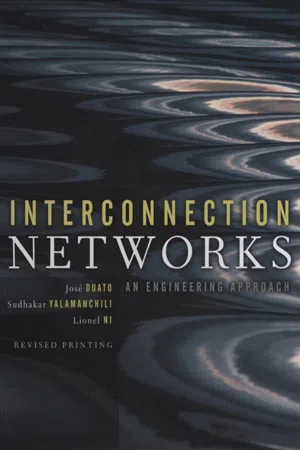![]()
CHAPTER 1
Introduction
Interconnection networks are currently being used for many different applications, ranging from internal buses in very large-scale integration (VLSI) circuits to wide area computer networks. Among others, these applications include backplane buses and system area networks; telephone switches; internal networks for asynchronous transfer mode (ATM) and Internet Protocol (IP) switches; processor/memory interconnects for vector supercomputers; interconnection networks for multicomputers and distributed shared-memory multiprocessors; clusters of workstations and personal computers; local area networks; metropolitan area networks; wide area computer networks; and networks for industrial applications. Additionally, the number of applications requiring interconnection networks is continuously growing. For example, an integral control system for a car requires a network connecting several microprocessors and devices.
The characteristics and cost of these networks depend considerably on the application. There are no general solutions. For some applications, interconnection networks have been studied in depth for decades. This is the case for telephone networks, computer networks, and backplane buses. These networks are covered in many books. However, there are some other applications that have not been fully covered in the existing literature. This is the case for the interconnection networks used in multicomputers and distributed shared-memory multiprocessors.
The lack of standards and the need for very high performance and reliability pushed the development of interconnection networks for multicomputers. This technology was transferred to distributed shared-memory multiprocessors, improving the scalability of those machines. However, distributed shared-memory multiprocessors require an even higher network performance than multicomputers, pushing the development of interconnection networks even more. More recently, this network technology began to be transferred to local area networks (LANs). Also, it has been proposed as a replacement for backplane buses, creating the concept of a system area network (SAN). Hence, the advances in interconnection networks for multicomputers are the basis for the development of interconnection networks for other architectures and environments. Therefore, there is a need for structuring the concepts and solutions for this kind of interconnection network. Obviously, when this technology is transferred to another environment, new issues arise that have to be addressed.
Moreover, several of these networks are evolving very quickly, and the solutions proposed for different kinds of networks are overlapping. Thus, there is a need for formally stating the basic concepts, the alternative design choices, and the design trade-offs for most of those networks. In this book, we take that challenge and present in a structured way the basic underlying concepts of most interconnection networks, as well as the most interesting solutions currently implemented or proposed in the literature. As indicated above, the network technology developed for multicomputers has been transferred to other environments. Therefore, in this book we will mainly describe techniques developed for multicomputer networks. Most of these techniques can also be applied to distributed shared-memory multiprocessors and to local and system area networks. However, we will also describe techniques specifically developed for these environments.
1.1 Parallel Computing and Networks
The demand for even more computing power has never stopped. Although the performance of processors has doubled in approximately every three-year span from 1980 to 1996, the complexity of the software as well as the scale and solution quality of applications have continuously driven the development of even faster processors. A number of important problems have been identified in the areas of defense, aerospace, automotive applications, and science, whose solutions require a tremendous amount of computational power. In order to solve these grand challenge problems, the goal has been to obtain computer systems capable of computing at the teraflops (1012 floating-point operations per second) level. Even the smallest of these problems requires gigaflops (109 floating-point operations per second) of performance for hours at a time. The largest problems require teraflops performance for more than a thousand hours at a time.
Parallel computers with multiple processors are opening the door to teraflops computing performance to meet the increasing demand of computational power. The demand includes more computing power, higher network and input/output (I/O) bandwidths, and more memory and storage capacity. Even for applications requiring a lower computing power, parallel computers can be a cost-effective solution. Processors are becoming very complex. As a consequence, processor design cost is growing so fast that only a few companies all over the world can afford to design a new processor. Moreover, design cost should be amortized by selling a very high number of units. Currently, personal computers and workstations dominate the computing market. Therefore, designing custom processors that boost the performance one order of magnitude is not cost-effective. Similarly, designing and manufacturing high-speed memories and disks is not cost-effective. The alternative choice consists of designing parallel computers from commodity components (processors, memories, disks, interconnects, etc.). In these parallel computers, several processors cooperate to solve a large problem. Memory bandwidth can be scaled with processor computing power by physically distributing memory components among processors. Also, redundant arrays of inexpensive disks (RAID) allow the implementation of high-capacity reliable parallel file systems meeting the performance requirements of parallel computers.
However, a parallel computer requires some kind of communication subsystem to interconnect processors, memories, disks, and other peripherals. The specific requirements of these communication subsystems depend on the architecture of the parallel computer. The simplest solution consists of connecting processors to memories and disks as if there were a single processor, using system buses and I/O buses. Then, processors can be interconnected using the interfaces to local area networks. Unfortunately, commodity communication subsystems have been designed to meet a different set of requirements, that is, those arising in computer networks. Although networks of workstations have been proposed as an inexpensive approach to build parallel computers, the communication subsystem becomes the bottleneck in most applications.
Therefore, designing high-performance interconnection networks becomes a critical issue to exploit the performance of parallel computers. Moreover, as the interconnection network...
